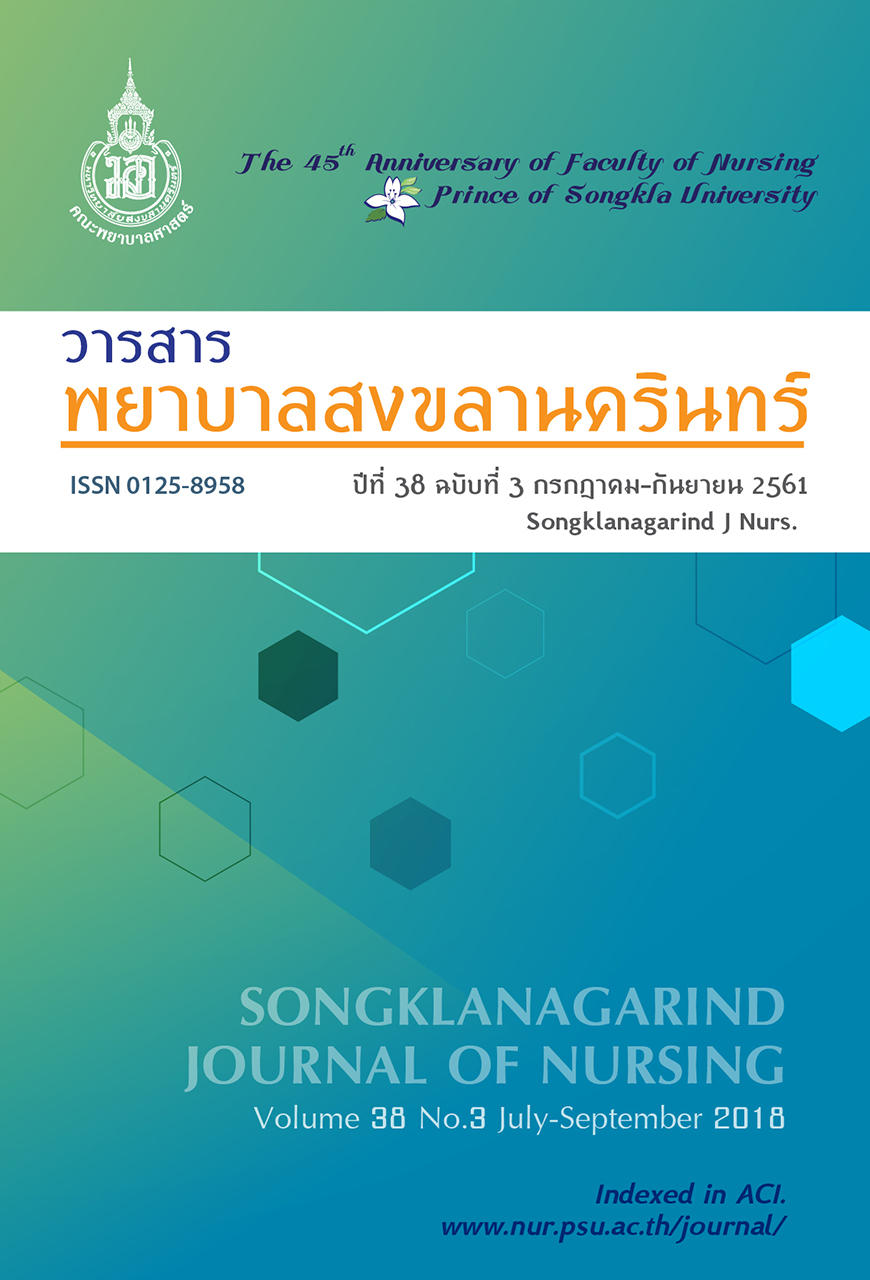Development of Nursing Practice Guideline for Preventing Complications in Bed-Bound Elders at Home
Main Article Content
Abstract
This study aimed to develop the nursing practice guideline for preventing complications in bedbound elders at home. Orem’s Nursing Theory, long term care for bed-bound elders and the clinical practice development process by the National Health and Medical Council, Australia were used as the conceptual framework of this study. The process of guideline development was divided into 2 phases. The first phase
consisted of 5 steps. The second phase, evaluation phase, consisted of 2 steps.
The guideline composed 4 components: 1) assessing problems and needs of the bed-bound elder,2) care planning to prevent complications from being bed-bound, 3) caregiving to prevent complications caused by being bed-bound at home using supportive educative nursing system based on Orem’s theory, and 4) follow-up assessment using a caregiver guide on preventing complications for bed-bound elders namely bedsore; joint stiffness and muscle weakness; respiratory infection; urinary tract infection and depression.
The content validity of the nursing practice guideline for preventing complications in bed bound elders at home was approved by 5 experts yielded the content validity index of 1.0. The inter-rater reliability yielded value of 99.2%
The developed practice guideline can be used to prevent complications for bed-bound elders.Effectiveness of nursing practice guideline is recommended for further study.
Article Details
References
2. The Thai Elderly’s Health Survey, 2013, under the Health Promotion Program for the Elderly and the Disabled. 1st ed. Health Elderly Health Group Ministry of Public Health: Printing PP Watcharin. 2013.
3. Wannapa S, Ladda D. Editor. Knowledge management and synthesis of practices of district health promotion hospitals. Elderly Services Practices. 1st ed. Nonthaburi: Sahamit Publishing Co., Ltd., 2010.
4. Wilaiwan T. Editor. The Art and Science of Nursing for elderly.1st ed. Textbook Project Faculty of Nursing Chiang Mai University: Bangkok; 2011.
5. Sumrit S, Kanittha B. Editor. Synthesis of Long-term Care System for the Elderly in Thailand. 1st ed. Bangkok: Q P; 2010. Thai.
6. Pukjira S. Editor. Care manual for paralysis/paralysis patients and patients in need of basic help.1st ed. Bangkok: Tontham; 2013.
7. Orem, D. E. Nursing concepts of practice. 6th ed. St.Louis, Missouri: Mosby. 2001.
8. Public Health Nursing Division. Home Health Care. Health desk: healthy living.2012.
9. National Health and Medical Research Council (NHMRC). A guide to the development, implemen-tation and evaluation of clinical practice guidelines. 1998.
10. Joanna Briggs Institute. JBI Levels of Evidence and Grades of Recommendation. 2014.
11. Banjongporn k. Effectiveness of clinical practiceguidelines implementation for pressure sore prevention in elderly with cerebrovascular disease at female medical Unit 1 Buddhachinaraj Hospital Phitsanuloke Province. [thesis].[Chiangmai]: Chiangmai University.2008. 50p.
12. Saifon T, Wipa S, Ploenpit T. Impact of a Skin Humidity Control Programme on Skin Integrity and Pressure Ulcers in Elderly Patients with Pressure Ulcer Risks. Thai Journal of Nursing Council. 2014; 29(1) 43-54.
13. Chulavary T. Effects of promoting familycaregiving on prevention of pressure sore and joint contracture in traumatic brain injured patients. [thesis].[Chiang Mai]. Chiang Mai University. 2006. 127p.
14. The Supreme Patriarchy Elderly Center. A Guide to Self-Care for stroke rehabilitation phase for patient and caregiver. Chonburi: Beyond Publishing Co., Ltd. 2011.
15. Pornthip C. Editor. Caring for Stroke Patients at Home for Public Health Personnel. Health desk: healthy living. 2012.
16. Yupin C, Jiraporn K. Dealing with Dysphagia in Elderly Stroke. Naresuan University Journal. 2007; 1(1) 18-31.
17. Saitip J. The Effect of Utilizing Nursing Practice Guidelines on Promoting Safety in Swallowing Among Stroke Patients With Dysphagia in Prachomklao Hospital Petchaburi Province. [thesis].Christian University of Thailand. 2007. 116p.
18. Chaweewan Y. Teaching plan for medical patients. Hat Yai: Nursing Services Department Songklanagarind Hospital. 2009.
19. Sirirat W, Ponghathai P, Pornnapa I, et al. Development of nursing practice guidelines for the prevention of urinary tract infections from urinary catheters. Journal of Nursing Division.2010; 37 (1): 51-65.
20. Polit,D.F., & Beck, C.T. Inferential Statistics. In Nursing Research: Generating and Assessing Evidence for Nursing Practice. 9 th ed. Philadelphia: Wolters Wolter Kiuwer Health/Lippincott Williams & Wilkins Health/Lippincott Williams& Wilkins.2012.
21. Fongkham T. Evidence-based nursing: principle and method/ Evidence-based nursing: principle and method. 5 th ed. Bangkok: Pre-one Partnership; 2009.


